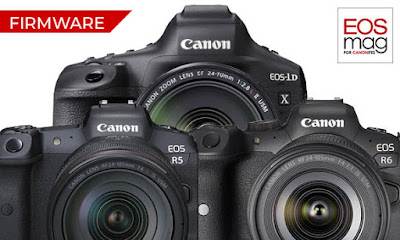Canon Europe today announces firmware updates for three of its EOS cameras, in response to customer feedback. Firmware v1.3 for the EOS R5 and EOS R6*, and firmware v1.4 for the EOS-1D X Mark III are designed to help streamline workflows and realise greater creative freedom.
Download the EOS R5 update:
https://www.canon.co.uk/support/consumer_products/products/cameras/digital_slr/eos-r5.html?type=firmware
Download the EOS R6 update:
https://www.canon.co.uk/support/consumer_products/products/cameras/digital_slr/eos-r6.html?type=firmware
(*EOS R6 firmware has since been updated to v1.3.1 as at 1 April 2021, which fixes a phenomenon with the previous release.)
Download the EOS-1D X Mark III update:
https://www.canon.co.uk/support/consumer_products/products/cameras/digital_slr/eos-1d-x-mark-iii.html?type=firmware
Increased image quality and usability
The latest firmware for the EOS R5 offers a number of upgrades, including Full HD 120p and support for greater customisation of the camera. Users will now able to save personalised and preferred camera settings to a memory card, which can be copied across to a different camera or used when settings are adjusted. There is also the option to turn the LCD monitor off during shooting and use for playback only, providing a familiar DSLR style operation.
For both the EOS R5 and EOS R6, the firmware achieves full time manual support for RF lenses, allowing photographers to override the focus of RF lenses manually when in Servo AF mode.
Streamlined professional workflows
For the EOS R5, photographers can safeguard and quickly share photos with the new Protect Image Transfer function allowing protected images to be locked – preventing them from accidentally being deleted – and transferred via FTP.
Across the EOS-1D X Mark III and EOS R5, professionals can now see FTP Transfer status on the display clearly showing how long it will take to transfer pictures.
Enhanced video functionality
This firmware enables low bit rate RAW movies – reducing the size of RAW video files – which in turn makes file transfer faster for the EOS R5 and EOS-1D X Mark III.
The update also provides enhanced video capabilities for the EOS R5 with the addition of Canon Log 3 – the log gamma curve used by all Canon Cinema EOS cameras. This enables greater dynamic range, superior colour editing capabilities and easier file management. For even greater flexibility of filming formats across all cameras, this firmware unlocks a lower bit rate IPB movie option for creating small, easily shareable video files.
Canon has also released several software updates today to complement the above firmware upgrades and bring support for Apple M1 processors via Rosetta for Digital Photo Professional (DPP) with v4.14 and EOS Utility with v3.13.1.
Further updates in the pipeline
Canon will continue its commitment to photographers and videographers through further plans to bring new functionality to these three models based on user feedback, including bringing Canon Log 3 to the EOS R6 and EOS-1D X Mark III in a future update.
Installation
Canon camera firmware updates can be installed by the user. You should always read the instructions supplied with the firmware update. For further guidance, see:
